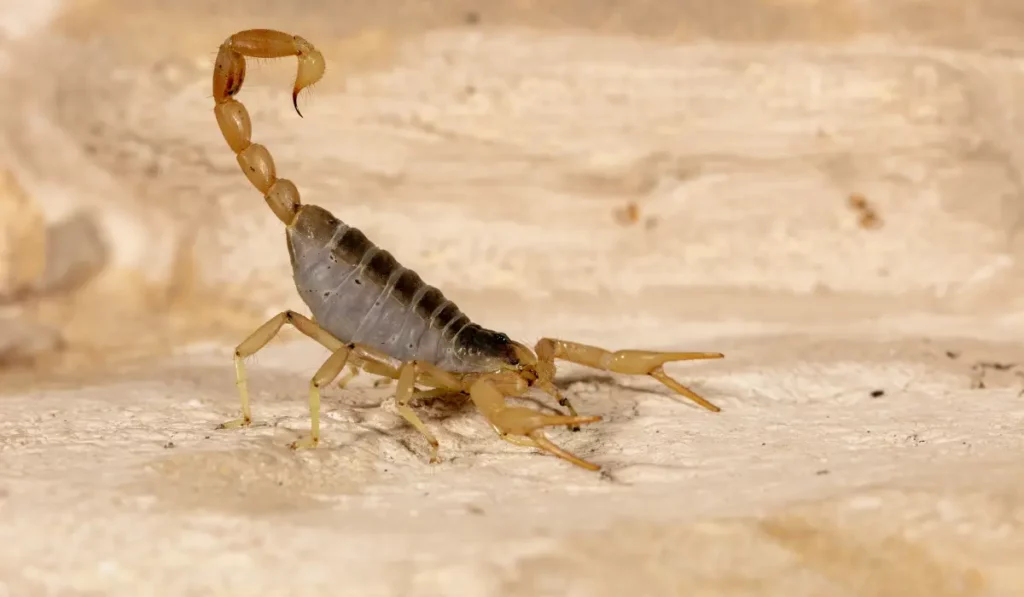Texas is known for its diverse wildlife, but one creepy creature raises eyebrows and accelerates heart rates – the scorpion. If you’re living in Texas, you’re likely to come across these intriguing yet intimidating creatures.
This article will delve into the world of scorpions in Texas, offering insight into whether they can pose a deadly threat, what occurs when you’re stung, and remedies to alleviate the discomfort.
Key Takeaways
- Most Texas scorpions, including the common Striped Bark Scorpion, are not deadly to most healthy adults.
- Expect pain, swelling, redness, and sometimes numbness from scorpion stings; severity varies by species and individual.
- Clean the sting area, apply a cold compress, and use pain relievers as immediate measures.
- Recognize Texas scorpions like the mildly dangerous Striped Bark, Texas Cave Scorpions, and the rare but potentially lethal Arizona Bark Scorpion.
Can Scorpions in Texas Kill You?

Encountering a scorpion in Texas might be unsettling, but the risk they pose is often less alarming than many believe. Texas is home to 18 native scorpion species, with the majority posing no lethal threat to humans. This is reassuring for both residents and visitors of the state.
The Arizona Bark Scorpion, known for its potent venom, has been seen but is not commonly found in Texas. Luckily, this dangerous scorpion is typically found in the southwestern U.S. and northwestern New Mexico.
This significantly lowers the chances of encountering a deadly species of scorpion. However, regular scorpions are still considered common pests.
It’s worth noting that scorpion venom potency often inversely correlates with their size. Larger scorpions, relying on their size and pincers, generally have less potent venom compared to smaller scorpions that depend on their venom for defense.
Thus, a scorpion with large claws and a small stinger is typically less dangerous than one with small claws and a large stinger. However, it’s best to call pest control services if you find one near your home.
Finally, while scorpion stings can vary in severity, globally, only about 3,250 scorpion-venom-related fatalities are reported annually. Essentially, these cases are rare, especially in regions like Texas, where life-threatening scorpions are uncommon.
What Happens if a Scorpion Stings You?
Experiencing a scorpion sting can be alarming, especially since scorpions may pop out of their hiding places and hurt you. Below are the typical reactions and effects:
- Venom Injection: When it stings, a scorpion injects venom primarily made of neurotoxins. This venom is used mainly to subdue their prey. But it can cause various reactions in humans due to its effects on the nervous system.
- Immediate Symptoms: The sting usually results in immediate pain, swelling, and redness at the affected site. Numbness or a tingling sensation akin to pins and needles might also occur.
- Duration of Symptoms: These symptoms can persist for several minutes to a few days, depending on the scorpion species, toxicity level, and the individual’s reaction.
- Severe Reactions: Symptoms can sometimes escalate, particularly in children or individuals with allergies. These may include difficulties in breathing, muscle twitching, or abnormal heart rates.
It’s essential to get medical treatment immediately if you experience severe symptoms or if the pain and swelling increase significantly, as these can be signs of a severe allergic reaction, similar to a bee sting causing anaphylaxis.
Scorpion Sting Remedies
If you’re unfortunate enough to experience a scorpion sting, there are several steps you can take to mitigate the discomfort.
- Clean the Wound: First and foremost, clean the wound with soap and water to prevent infection.
- Apply a Cold Compress: Applying a cold compress to the sting site can reduce swelling and numb the pain.
- Use Pain Relievers: Over-the-counter pain relievers can aid in managing discomfort.
- Consider Antihistamines: Antihistamines may help reduce swelling and alleviate allergic reactions.
- Rest and Elevate: It’s crucial to keep the affected area still and elevate it, if possible, to slow down the venom’s spread.
Remember, while these remedies can alleviate symptoms, they do not substitute for professional medical attention or antivenom (a.k.a. antivenin), particularly if severe reactions or symptoms persist. In such scenarios, you should seek medical help immediately.
Types of Scorpions
Below are the most common types of Texas Scorpions. You’ll notice the majority are only mildly dangerous, while one (the Arizona Bark Scorpion) is potentially lethal. It’s less common in Texas but has been seen there before.
Make sure you take note of the characteristics of these scorpions in particular:
| Scientific Name | Common Name | Identifying Characteristics | Sting Danger to Humans |
| Centruroides vittatus | Striped Bark Scorpion | Yellowish-brown with two dark stripes on the back; about 2.5 inches long | Mild to moderate |
| Centruroides sculpturatus | Arizona Bark Scorpion | Pale, yellow-brown; slender tail; up to 3 inches long | High, potentially lethal (rare, but has been seen) |
| Hadrurus spadix | Giant Desert Hairy Scorpion | Large, hairy, yellow with a dark top; can reach up to 6 inches | Mild |
| Vaejovis spinigerus | Stripe-tailed Scorpion | Dark back with lighter stripes; about 2 inches long | Mild |
| Diplocentrus whitei | Texas Cave Scorpion | Brown or reddish-brown; medium-sized with a robust body | Mild |
| Pseudouroctonus reddelli | Big Bend Scorpion | Dark brown or black; about 2 inches long; commonly found in the Big Bend region | Mild |